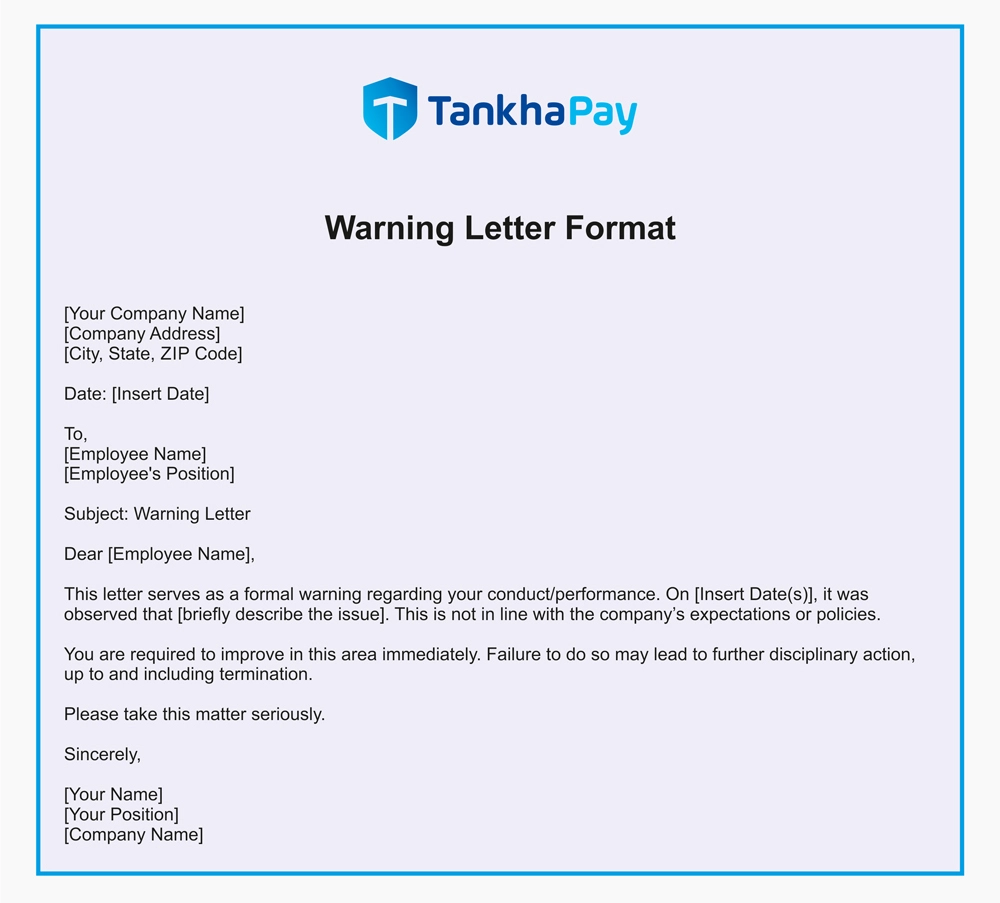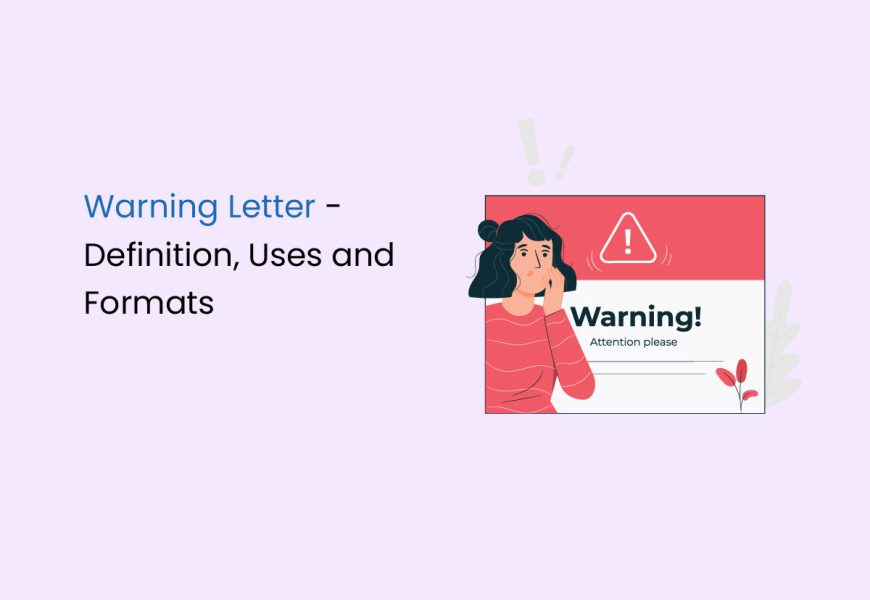Employee misconduct and negligence within the workplace can indeed carry profound repercussions. Such conduct breaches necessitate issuing a verbal and written warning letter and, in severe cases, may even culminate in termination.
Every organisation has a different way of handling employee infractions. The protocol changes depend on the severity of the misconduct.
This blog will discuss an employee warning letter – its meaning, use, need, and how to write it.
What is a Warning Letter?
An employer provides a warning letter to an employee as an official document to address a violation of company policies or protocols. This letter is to notify the employee of their wrongdoing and outline potential disciplinary actions. Upon receiving the warning, the employee acknowledges its reception by signing it, and a duplicate is kept in their personnel records.
A warning letter is primarily used to notify an individual of their mistakes and the necessary steps they need to take to rectify the situation. It should clearly state the problem created by an employee and give them a fair and reasonable opportunity to improve their performance. A company can issue a warning letter to take corrective action and resolve employee-related issues.
This type of intervention is known as a performance improvement plan, or PIP.
If any of a company’s rules are broken, it is mandatory to lay out the company policies and regulations in an employee handbook, which includes the plan for employee discipline. This helps all employees to be aware of what is expected of them and what consequences they should expect if they fail to meet the company’s expectations. Typically, one or more verbal warnings are given before a written warning is issued, which may be accompanied by other consequences like closer supervision or unpaid leave. All warnings should be provided following the company’s discipline plan to avoid any claims of discrimination in the workplace.
Features of Using a Warning Letter
Some of the features of using a warning letter to an employer are as follows:
- Stamping or e-registering a warning letter is recommended, even though it is not compulsory.
- Once registered, it serves as proof of a contract or document executed.
- If the employer is lenient, multiple warning letters can be used.
- Use effective and non-misleading language to ensure the letter is precise and compact.
- The employer should avoid hostility in communication.
- The letter must be drafted on the letterhead of the company.
- A warning letter can also be issued by a government or regulatory body to another corporate body for non-compliance, negligence, not adhering to the laws of the land, improper disposal of waste, etc.
- An employee can take legal action if fired without a warning letter before dismissal.
How To Draft A Warning Letter?
A warning letter is a letter that can be quickly drafted and has various uses depending on its purpose and contents. If the recipient persists in the behaviour, a termination or relieving letter may be issued following the warning letter. You can use our template to draft warning letters for different purposes. Furthermore, we have e-registered the document and received a stamp.
What to Include in a Warning Notice?
Here are the key elements and details typically included in a warning letter:
- Introduction: The warning letter starts with an introduction that identifies the employee and the letter’s purpose. It may also refer to previous discussions or informal warnings about the specific issue.
- Description of Concerns: The letter clearly outlines the specific performance or behavioural issues that have led to the warning. It provides an objective and factual description of the problem, including relevant dates, incidents, or examples. The letter may also reference policies, rules, or expectations that have been violated.
- Impact and Consequences: The letter highlights the impact of the employee’s actions or behaviour on the organisation, team members, or work environment. It may discuss how the issues have affected productivity, customer satisfaction, team dynamics, or other essential aspects. Additionally, the letter may mention the potential consequences if the employee fails to improve, ranging from further disciplinary action to termination of employment.
- Expectations and Improvement Plan: The warning letter outlines the specific expectations for improvement. It may guide what actions or behaviours the employee should demonstrate moving forward. This can include targets, deadlines, or specific steps to be taken. The letter may also mention any support, training, or resources that will be given to assist the employee in meeting the expectations.
- Signature and Acknowledgment: The warning letter is usually signed by the issuing authority, such as a supervisor, manager, or human resources representative. The employee is generally required to acknowledge reception of the notice by signing and returning a copy or providing a written response to indicate understanding.
You should include the following elements in your employee warning notice:
- Company name
- Warning number
- Name of employee and job title
- Name of supervisor
- Name of HR representative
- Date of issue
- Introductory statement
- Infractions incurred by the employee
- Consequences of failure to correct infractions
- Supervisor signature and date
- Employee acknowledgement statement
- Employee signature and date
Warning Letter Format
[Company Address]
[City, State, ZIP Code]
Date: [Insert Date]
To,
[Employee Name]
[Employee’s Position]
[Employee’s Department]
Subject: Formal Warning Letter
Dear [Employee Name],
I hope this letter finds you well. This letter is being issued as a formal warning concerning your conduct and/or performance in your role as [Employee’s Position] at [Company Name].
Details of the Issue:
On [Insert Date(s)], it was observed that [describe the incident(s) or behavior]. This behavior is in direct violation of [mention any relevant policies, guidelines, or expectations, if applicable].
Previous Discussions (if any):
As you are aware, this issue was previously addressed on [Insert Date(s)] during [a meeting, informal warning, etc.]. Despite these discussions, we have not seen the necessary improvement in [performance/behavior].
Impact of the Issue:
This behavior has [explain how the issue has impacted the company, team, or employee’s work, e.g., delays in projects, disruption in workflow, etc.].
Required Improvement:
We expect you to take immediate action to address the concerns mentioned above. Specifically, you are required to [outline the steps the employee needs to take to correct their behavior/performance].
Consequences of Further Infractions:
Please be advised that failure to show improvement or any further violations of company policy will result in [outline the next steps, which may include further disciplinary actions such as suspension, or termination].
We believe in your potential to contribute positively to the team and hope that you will take this letter seriously as an opportunity to improve.
If you have any questions or if you need support in making the necessary improvements, please don’t hesitate to reach out to [Manager/Supervisor’s Name].
Yours sincerely,
[Your Name]
[Your Position]
[Company Name]

Example of Warning Letters
If you are getting stumped about what to write in a warning letter, here are a few examples of employee warning notices to help you out:
Example 1: Issues with Attendance and Absenteeism
Employer’s full name:
Office address:
Subject: Warning for attendance
Dear (Employee’s name),
As you are aware, your attendance could be better. You were given multiple verbal warnings from your manager to improve, but you failed.
We consider attendance a crucial matter and expect you to provide it with the same importance from now on. Your frequent absence is causing a negative impact not just on your work but also on the productivity of the entire team. Each employee is responsible for specific tasks and duties; failing to fulfil them affects the team’s motivation and overall performance.
We also know that you take leave without prior intimation and often log out much before your work timing, even when there is pending work.
This letter serves as your first official warning. You are given (weeks/months permitted) to improve your attendance. If you ignore this warning or fail to regularise your attendance by the allotted time, we must take stricter actions, including suspension and termination.
Please get in touch with me to discuss this letter or appeal against the decisions mentioned. That said, we are here to know and support you if any problems lead to this situation.
Best,
(Name)
(Signature)
Example 2: Email About Absenteeism
[Employee’s email]
Subject: Warning notice for [attendance] / Warning notice / Final warning notice
Dear [Employee’s name],
As we’ve recently discussed, your [absenteeism] negatively affects your performance at work and your team’s productivity. We take [attendance at work] seriously and expect all employees to [comply with our company’s policy regarding time off].
However, despite reprimands, you have regularly violated [this policy] and [have exceeded the days you can get a leave from work]. More specifically, [in the last month, you didn’t show up at work on X, Y, or Z without prior notice to HR or your manager]. We understand that unexpected issues may arise occasionally, and we [are flexible]. But, we still expect our employees to be professional and act in our company’s best interest.
This is your [first] warning letter. We expect you to correct your behaviour and [request time off in advance and in a formal way]. Otherwise, we will have to take further disciplinary action, including termination.
I’m available to discuss any complications that cause your [absence at work]. Please get in touch with me directly if there’s any way I can help you.
Sincerely,
[Your name]
[Your email signature]
Example 3: Issues with Discipline
Employer’s full name:
Office address:
Re: Warning for a disciplinary issue
Dear (Employee’s name),
It has come to our knowledge that you (misconduct the employee did) at/on the (respective) event/day. We want to emphasise that our company does not expect or tolerate this behaviour.
We immediately put you on a (duration) warning period. During this time, your behaviour will be closely monitored.
Please take this warning letter seriously; we do not tolerate company policy violations. We expect you to apologise (in case of fights/harassment) / improve your behaviour, and furnish a written apology within three days.
If you do not submit an apology or refrain from repeating the mistake, we will have to take stricter actions, including but not limited to suspension and termination.
Each employee is valuable to us, and you are our asset. As such, we want you to better yourself. Please contact me directly if you wish to appeal against this decision or discuss anything related to this letter.
Best,
(Name)
(Signature)
Example 4: Subpar Performance
Employer’s full name:
Office address:
Re: Warning notice for poor performance
Dear (Employee’s name),
Dear [Name],
We have noticed that your performance is consistently falling short of our company standards. You are not meeting assigned deadlines, delivering quality work, or reaching your individual goals. This letter serves as the first official warning and is intended to enlighten you about the consequences if you fail to improve.
You are given a duration of [weeks/months permitted] to take the actions listed below and ameliorate your unsatisfactory performance:
- Improve the quality of your work
- Meet all assigned deadlines
- Reach your individual goals
Please be aware that failure to improve your performance within the given time frame may result in further disciplinary action, up to and including termination of your employment.
We believe in your potential and hope you will take the necessary steps to improve your performance.
You may contact me directly to appeal against this decision or discuss anything related to this letter.
Best,
(Name)
(Signature)
How to Warn an Employee
When providing disciplinary action to an employee, it is crucial to remain calm and professional. Usually, the warning should come from a direct supervisor in a one-on-one meeting where the infraction and warning can be discussed to ensure everyone is on the same page moving forward. Depending on the company policy, a representative from HR or some other third party may also be present during the meeting. Furthermore, it is recommended that the meeting concludes with a positive statement. Express that the company aims to motivate and improve employee relationships and chances for mutual success.
Why Do You Need A Warning Letter?
A warning letter is an important document that employers use before taking disciplinary action or terminating an employee’s contract. Firing an employee without prior warning or due process can result in legal consequences. This principle also applies to rental agreements; just as a landlord cannot evict a tenant without notice, employers are generally expected to provide employees with sufficient warnings or opportunities to improve before taking drastic measures.
Some of the reasons employers issue warning letters to employees are as follows:
- Negligence
- Failure to reach targets
- Working for multiple companies
- Office violence (physical or verbal)
- Violation of company rules and regulations
- Disregard for discipline
- Gross misconduct
- Poor or late attendance and unauthorised leaves
- Complaints by co-employees
Reasons to send an Employee Warning Letter
Employee Warning Letter is sent to:
- Document any employee misconduct or poor performance, and explain the consequences of their actions.
- Provide clear and constructive feedback to the employee regarding the nature and severity of the issue.
- Set clear and realistic expectations for improvement, including a specific timeframe for achieving these goals.
- Offer the employee an opportunity to correct their behaviour or performance before taking more serious disciplinary actions.
- Taking these steps can help protect the employer from legal liability in the case of termination or other legal action.
Tips for Writing a Good Warning Letter
Some tips for writing a good warning letter are as follows:
- Language & tone: Write formally and professionally in a way that stresses the seriousness of the situation. However, ensure that the language used is not too strong.
- Structure: The format in which you write the formal letter is essential. When creating a warning letter, include the following points:
- Date the warning is issued
- Name and address of the person issuing the letter
- Subject
- Name of the employee
- A section detailing the violation
- Reasons why this situation is considered a violation of company policies
- Disciplinary actions that the organisation will take
- Your signature should be included at the end.
- Content: Be concise and avoid repetition. Long sentences that do not serve a purpose should be avoided. Shorter letters are more effective and to the point. Stick to the facts and avoid being overly emotional. Adding the date can help increase credibility.
- Proofread: Review the letter to check for minor errors. Check the recipient and details for accuracy.
- Acknowledgement: Confirm if the employee has received the warning letter. Ask the employee to sign a physical letter or request a follow-up if it was an email.
What If Employee Refuses To Sign?
When an employee receives a warning letter, they should sign the letter to acknowledge that they have received it. However, this signature should not be taken as an admission of the criticisms mentioned in the warning letter. If an employee refuses to sign, a witness can acknowledge that the employee has received the warning letter.
Conclusion
When writing a warning letter, it’s crucial to provide support, clarifications, and assistance to the individual. Always take the time to listen to their side of the story, and avoid jumping to conclusions or making personal attacks. The ultimate goal is to improve their performance, attendance, or behaviour. To prevent performance-related issues from leading to the issuance of warning letters, consider using a performance management system. This system allows you to track every goal, sub-goal, and target. It ensures that they are completed within the required timeframe, whether monthly, quarterly, or annually.
Frequently Asked Questions about Warning Letter
How do I write a written warning letter?
A clear and concise employee written warning includes:
- Name of the organisation
- The warning number
- Employee’s Name and their salutation
- Supervisor’s Name
- Human Resources Representative’s name
- Date of issuing the warning
- A statement of introduction
- Mistakes of the employee
- Repercussions if the employee fails to improve them
- Signature of the supervisor and the date
- Acknowledgement statement by the employee
- Signature of the employee and the date
Is a warning letter considered as a disciplinary action?
In many workplaces, warnings are part of a progressive disciplinary system. The first step is often a verbal warning, followed by a written warning if the behaviour or performance issue persists. This allows employees to correct their actions and improve their performance before more severe disciplinary action is taken.
Should you send a warning notice?
It is essential to issue an official documented communication in the form of an employee warning notice when there is a violation of company policy, especially if prior verbal warnings have been given.
Why is a warning notice important?
A notice to notify an employee of their misconduct, commonly known as an employee warning notice, is essential for the following reasons:
- It formally informs the employee of their misconduct.
- It creates a record of the disciplinary action taken.
- It communicates the seriousness of the situation, ensuring clarity and transparency in the disciplinary process.
What should be the tone of a warning notice?
The tone should be respectful yet firm and professional, clearly communicating the seriousness of the misconduct while offering a clear path for the employee to rectify their behaviour.





















